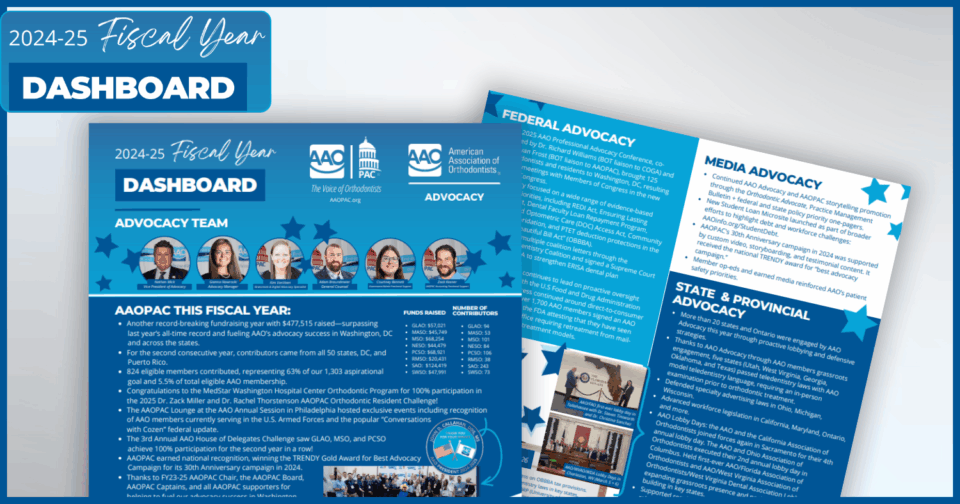On March 27, 2020, President Trump signed the CARES Act, a relief package that addresses unemployment benefits, small business loans, the Paycheck Protection Program (PPP), the Economic Injury Disaster Loan (EIDL) and more. The AAO Legal and Advocacy team supported the passage of this legislation and worked alongside other dental organizations to advocate on behalf of AAO members.
Below is an analysis of unemployment insurance, PPP and EIDL with targeted strategy and suggestions from Cain Watters and Associates for how these programs will affect orthodontists specifically. The AAO encourages its members to familiarize themselves with the programs described below and seek additional guidance from local lenders and your own legal counsel for more specific guidance and instruction.
Strategy and Suggestions from Cain Watters and Associates CPAs
The passage of the most recent relief bill, also known as the CARES Act, is a direct response to the challenges small businesses across the country are facing. The bill covers much more territory in its 880 pages, but it is critical for business owners to be aware of its provisions and understand the nuances in order to maximize the usage of the bill. The ultimate goal is to have the needed cash flow available when you reopen your practice to deal with the surge in patient appointments.
Before looking at the bill, orthodontic practices must first understand how to estimate cash flow over the coming 60-120 days. CWA recommends starting with your total contracts receivable and dividing this by your average contract length (typical 18-22 months).
Importantly, you will need to include only the contracts receivable related to insurance payments or patient accounts on which you have auto bank drafts or credit card payments. This number should then be multiplied by 85% to 90% to account for card declines during this period of uncertainty.
CWA’s average orthodontic practice has contracts receivable equaling 60% of production. Which means if your office produces $1,000,000 annually, your contracts receivable should be approximately $600,000. If your average remaining contract length is 15 months, then you should expect that your collections will be $40,000 in the first month with no additional contracts added, then decrease from there by 5-7% per month.
Once you understand your cash flow and base expenses over the next 90 days you can better understand how to utilize the main components of the CARES Act. This will allow you to create a strategy to protect your business and your employees.
Below is our summary of the three main components of the CARES Act, as well as strategy for orthodontists for each.
Expanded Unemployment Insurance (UI)
This includes a $600 per week increase in benefits for up to four months and federal funding of UI benefits provided to those not usually eligible for UI, such as the self-employed, independent contractors and those with limited work history.
This benefit will be on top of the regularly qualified state UI your staff is already receiving or will be receiving. The additional payments will last through July 31, 2020 or until your staff returns to work. This is an enormous benefit for your furloughed or laid-off employees. This allows you to proceed with the next section (Small Business Administration loan) in a reasonable and prudent manner.
CWA Comments / Strategy
The theory behind this part of the bill is a benefit for the millions of businesses that have been closed and laid off employees. With the ADA’s recommendation that dentists nationwide postpone elective procedures in an effort to do their part to “mitigate the spread of COVID-19”, many dental practices are also proceeding with a lay-off or furlough of employees while the office is closed to non-emergency treatment. The ADA updated their guidance just last week, defining emergency orthodontic care as care that will relieve pain and/or infection, is trauma-related or is critically necessary to prevent harm to the patient.
The House wanted to get minimum wage at $600 a week, which correlates to $15 dollars an hour on a 40-hour week. For a typical CWA practice staff member that makes $25 dollars an hour, they should now receive approximately $400 in state unemployment, plus the additional $600 on a weekly basis. This is nearly the equivalent of 100% of their salary. This additional $600 benefit is available through July 31, 2020, which allows you to re-build your practice in the most efficient manner possible as you reopen your doors.
For many orthodontic practices, it will still be important to maintain a minimal amount of staff to help with emergency treatment, virtual consult scheduling, and ongoing insurance and contracts receivable collections. We would still recommend furloughing the staff and bringing them back in limited hours for this work to be done. This will allow these employees to still earn unemployment in weeks where they do not work significant hours.
$350 Billion Allocated for the Paycheck Protection Program (PPP)
These loans will be provided by the Small Business Administration (SBA) and are meant to help small businesses (fewer than 500 employees) impacted by the pandemic and economic downturn make payroll and certain other expenses.
The covered period for receiving a loan is Feb. 15 to June 30, 2020. The maximum loan amount will be 2.5 times the trailing 12-month average of your payroll and payroll related expenses, including health and retirement benefits limited to the compensation of employees (including the doctors) up to a maximum amount of $100,000 annualized per employee. These loans became available on April 3 for corporations and sole proprietorships and will be available April 10 for self-employed individuals.
The loans have a forgiveness feature that begins on the date your loan originates, if the proceeds are used within 8 weeks for qualified expenses. Qualified expenses include payroll, interest payments on mortgages, rent, utilities and interest on other business debt obligations.
Interest is only allowed if the loan was in place prior to Feb. 15, 2020. Forgiveness of the loan is still possible even if you have laid-off employees after Feb. 15, 2020, so long as you re-hire to the same number of full-time employees, at their full rate, by June 30, 2020. If you have not re-hired to the same number of full-time employees, a portion of the qualified expenses would not be forgiven based on a formula in the reduction of employees and their salary levels.
CWA Comments / Strategy
The application process and timing of the receipt of these funds will be critical in building your practice back to full speed. This loan will not be a one-size-fits-all strategy. You must not let taxes or forgiveness decide how you run your business. CWA recommends that all its clients apply for this loan, but the use of the proceeds may differ on a client by client basis.
We recommend that borrowers open a new bank account with the bank originating your loan. This will allow you to more easily process and use the proceeds for only qualified expenses, and for the bank to document your forgiveness to the SBA. We strongly believe that using this loan in conjunction with the increased UI for staff will allow you to bring back staff as the practice increases, while also protecting your staff and your business in the meantime.
The most important planning strategy of this loan is to make it work for your practice when you re-open and actually have production. At this time, many banks are allowing you to apply for this loan now, but delay receipt of the funds until your practice is back open. Our recent blog has more information on how to communicate this to a bank.
While many orthodontic practices have ongoing cash flow from contracts receivable, the PPP loan will be helpful as you reopen your office in paying your staff salaries, rent and utilities. This will allow you to use the cash flow from your contracts receivable to help pay your lab and supply costs on new starts.
The Economic Injury Disaster Loan (EIDL)
This establishes an emergency grant to allow a dental practice that applies for an EIDL loan to receive an advance on that loan of no more than $10,000, which the SBA must distribute within three days.
The money may be used to pay for employee sick leave (COVID-19-related), mortgage or rent and other overhead expenses. This is a $10 billion fund and will be awarded on a first come first served basis. Importantly, any forgiveness of this $10,000 grant will reduce the forgiveness available on the PPP loan dollar for dollar.
In addition to the $10,000 grant, a business can receive additional amounts from the EIDL that can be used to help pay for ordinary, ongoing expenses in the practice. The CARES Act is clear that you can apply for both an EIDL and PPP loan, but the funds (beyond the $10,000 grant) cannot be used for the same purpose.
On April 2, further guidance on the CARES Act was released by the SBA as it pertains to EIDL and PPP loans. The release clearly states a borrower that has received EIDL proceeds prior to April 3 can still apply for a PPP loan. The release does not state that a borrower that has applied for and not received an EDIL cannot also apply for a PPP loan. In fact, CWA has received separate communication from the SBA that a borrower can apply for both an EIDL and PPP loan. You must not use the EIDL proceeds for the same purpose as the PPP loan. The proceeds of the EIDL can be used as a strategy for long term cash outside of the eight-week PPP loan.
CWA Comments / Strategy
Since the forgiveness under EIDL and PPP loans is still capped at 250% of the average month of payroll expenses, CWA recommends obtaining an EIDL for practices that have longer term cash flow concerns. These loans take longer to fund and therefore will not likely be funded before PPP loans. However, given the favorable loan terms on EIDLs these make sense for practices that are concerned with cash flow in Fall 2020 or Spring 2021.
For orthodontic practices, cash flow will likely be tighter the longer practices are closed down. Once a practice reopens it will take several months for contracts receivable to build back up. An EIDL could be helpful during this time period.
This is an unprecedented time for orthodontic practice owners. By creating a strategy that utilizes your own cash flow and the stimulus resources, your practice can and will make it through this. Our advisors are working around the clock to understand the nuances of the bills. For updates, webinars and blogs, please visit cainwatters.com/covid-19.
___________
Cain Watters is a Registered Investment Advisor. Cain Watters only conducts business in states where it is properly registered or is excluded from registration requirements. Registration is not an endorsement of the firm by securities regulators and does not mean the adviser has achieved a specific level of skill or ability. Request Form ADV Part 2A for a complete description of Cain Watters investment advisory services. Diversification does not ensure a profit and may not protect against loss in declining markets. Past performance is not an indicator of future results. This communication is for education purposes only and should not be considered personal financial advice.
___________
The AAO legal and advocacy team will continue to work with our federal lobbyists to monitor any federal measures to address the impact that COVID-19 is having, or will have, on our members as healthcare professionals and small business owners and, where appropriate, lobby for inclusion of our members in such relief measures.
Additionally, the ADA is encouraging its members to contact Treasury Secretary Steven Mnuchin to request that the Department of the Treasury clarify that EIDL and PPP loans may be used alongside one another in response to the Coronavirus outbreak and related closures. AAO members who wish to contact Secretary Mnuchin to make such a request, may access the ADA issue alert and sign on here.



